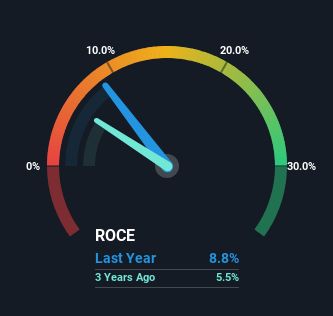Did you know there are some financial metrics that can provide clues of a potential multi-bagger? Firstly, we'd want to identify a growing return on capital employed (ROCE) and then alongside that, an ever-increasing base of capital employed. Put simply, these types of businesses are compounding machines, meaning they are continually reinvesting their earnings at ever-higher rates of return. However, after investigating T-Mobile US (NASDAQ:TMUS), we don't think it's current trends fit the mold of a multi-bagger.
Understanding Return On Capital Employed (ROCE)
If you haven't worked with ROCE before, it measures the 'return' (pre-tax profit) a company generates from capital employed in its business. The formula for this calculation on T-Mobile US is:
Return on Capital Employed = Earnings Before Interest and Tax (EBIT) ÷ (Total Assets - Current Liabilities)
0.088 = US$16b ÷ (US$206b - US$21b) (Based on the trailing twelve months to March 2024).
Thus, T-Mobile US has an ROCE of 8.8%. In absolute terms, that's a low return and it also under-performs the Wireless Telecom industry average of 15%.
See our latest analysis for T-Mobile US

Above you can see how the current ROCE for T-Mobile US compares to its prior returns on capital, but there's only so much you can tell from the past. If you're interested, you can view the analysts predictions in our free analyst report for T-Mobile US .
So How Is T-Mobile US' ROCE Trending?
In terms of T-Mobile US' historical ROCE trend, it doesn't exactly demand attention. The company has employed 166% more capital in the last five years, and the returns on that capital have remained stable at 8.8%. Given the company has increased the amount of capital employed, it appears the investments that have been made simply don't provide a high return on capital.
What We Can Learn From T-Mobile US' ROCE
As we've seen above, T-Mobile US' returns on capital haven't increased but it is reinvesting in the business. Investors must think there's better things to come because the stock has knocked it out of the park, delivering a 133% gain to shareholders who have held over the last five years. However, unless these underlying trends turn more positive, we wouldn't get our hopes up too high.
On a final note, we've found 2 warning signs for T-Mobile US that we think you should be aware of.
While T-Mobile US isn't earning the highest return, check out this free list of companies that are earning high returns on equity with solid balance sheets.
Valuation is complex, but we're here to simplify it.
Discover if T-Mobile US might be undervalued or overvalued with our detailed analysis, featuring fair value estimates, potential risks, dividends, insider trades, and its financial condition.
Access Free AnalysisHave feedback on this article? Concerned about the content? Get in touch with us directly. Alternatively, email editorial-team (at) simplywallst.com.
This article by Simply Wall St is general in nature. We provide commentary based on historical data and analyst forecasts only using an unbiased methodology and our articles are not intended to be financial advice. It does not constitute a recommendation to buy or sell any stock, and does not take account of your objectives, or your financial situation. We aim to bring you long-term focused analysis driven by fundamental data. Note that our analysis may not factor in the latest price-sensitive company announcements or qualitative material. Simply Wall St has no position in any stocks mentioned.
Have feedback on this article? Concerned about the content? Get in touch with us directly. Alternatively, email editorial-team@simplywallst.com
About NasdaqGS:TMUS
T-Mobile US
Provides wireless communications services in the United States, Puerto Rico, and the United States Virgin Islands.
Proven track record and fair value.
Similar Companies
Market Insights
Community Narratives


